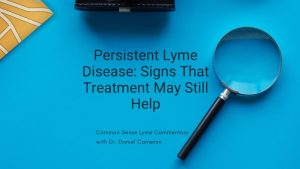Call for your appointment today 914-666-4665 | Mt. Kisco, New York

The three study groups were all prescribed 2 weeks of intravenous ceftriaxone. Two of the three groups were prescribed an additional 12 weeks of oral antibiotics, either doxycycline or a combination of clarithromycin with hydroxychloroquine. [1]
The quality of life (QOL) for Netherlands patients with persistent symptoms associated with Lyme disease was poor before antibiotic treatment, explains Berende from Radboud University Medical Center. The physical component score (PCS) measure of QOL averaged 32 to 33 prior to treatment. [2] Their PCS scores of 31 to 32 were worse than those of diabetic and cancer patients, who have scored 42 and 41, respectively. Meanwhile, PCS scores have been reported to be 50 for the general population. [3]
The QOL for Netherlands patients with persistent symptoms associated with Lyme disease barely improved with either a 2-week or 14-week course of antibiotics. Their PCS score rose an average of 3 points leaving them far short of the average score of 50 for the general population.
[bctt tweet=”Netherlands patients who have persistent symptoms associated with Lyme disease pay a high price in productivity losses and lower quality of life. ” username=”DrDanielCameron”]
Why did the patients in the Netherlands trial fail treatment? The trial may have enrolled the most difficult to treat patients. The Netherlands trial enrolled patients who had been sick for an average of 2.7 years and who had failed an average of two previous treatments. The Klempner and Fallon National Institute of Health (NIH) trials also enrolled patients ill an average of 4.7 to 9 years, who had failed previous treatment.
Neither the Netherlands nor the NIH trials allowed the investigators to individualize therapy for the most difficult to treat patients. There are a range of treatment regimens utilized in clinical practice that address the growing number of B. burgdorferi strains and tick-borne co-infections.
As investigators demonstrated, the costs are high for these patients whether you are measuring Quality of Life or productivity loss. It would appear premature to cut-off treatment options for our most difficult patients.
Related Articles:
Quality of life for Lyme disease patients in the Netherlands can be grim
Melting pot of tick-borne pathogens found in European hedgehogs
Children in Netherlands remain ill with post-treatment Lyme borreliosis syndrome
References:
- Berende A, Nieuwenhuis L, Ter Hofstede HJM, et al. Cost-effectiveness of longer-term versus shorter-term provision of antibiotics in patients with persistent symptoms attributed to Lyme disease. PLoS One. 2018;13(4):e0195260.
- Berende A, ter Hofstede HJ, Vos FJ, et al. Randomized Trial of Longer-Term Therapy for Symptoms Attributed to Lyme Disease. N Engl J Med. 2016;374(13):1209-1220.
- Cameron D. Severity of Lyme disease with persistent symptoms. Insights from a double-blind placebo-controlled clinical trial. Minerva Med. 2008;99(5):489-496.



